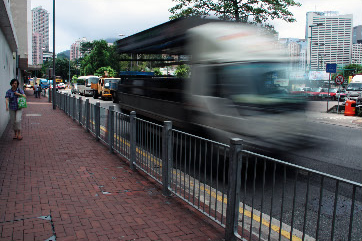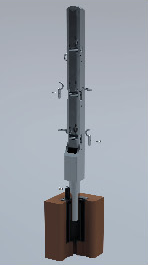
A set of FlexiBOL is installed in Causeway Bay of Hong
Kong
Street functions have become increasingly dynamic in recent years.
Streets are used daily by pedestrians and vehicular traffic, but also
serve a number of other functions, such as serving as the locale for
irregular or even unexpected events. Hong Kong residents are familiar
with a host of events that take place on the territory’s streets, for
example, the Lunar New Year Night Parade, the Hong Kong Marathon and
political rallies. Many thousands of people gather on the streets to
participate in these events or simply to take a peep at the action,
thus requiring the Police and the Transport Department to implement a
number of crowd management measures, including closing walkways and
roads and rerouting traffic. Controlling crowds and managing the flow
of traffic not only require a significant amount of manpower, but also
the adjustment of such street furniture as bollard and railing systems.
Existing bollard and railing designs, however, are not sufficiently
flexible to allow these adjustments to be made with ease.
In collaboration with the Hong Kong Highways Department, related
government departments and social organisations, Prof K W Michael Siu
has led a team of researchers and designers in carrying out applied research projects whose aim is to
generate flexible design solutions to meet today’s continuously
changing urban needs. On the basis of long term site observations and
product analysis of existing street furniture, the research team has
developed a set of bollards and railings designed to meet the needs of
Hong Kong and other densely populated metropolitan areas.

The design of FlexiBOL allows flexible applications
for different purposes
|
|
In addition to advocating new directions for flexible design, Prof
Siu’s team has developed a new bollard system design: FlexiBOL®.
FlexiBOL constitutes a design and engineering
breakthrough that will allow those responsible for crowd management to
cope with the dynamic requirements of densely populated urban
environments. The new design overcomes the limitations of existing,
old-fashioned bollard systems, such
as vertically erected bollard systems, which are difficult to erect on
the shallow walkways and roads that are common in Asian cities and that
need to accommodate the installation of underground utilities. The
operation and maintenance of these old-fashioned systems are also
complicated, and the methods of attaching additional components for
other purposes are complicated and difficult.
The FlexiBOL system, in contrast, is designed to match modern urban
lifestyles, and its flexible design allows it to be easily modified in
form to meet a variety of social, physical and environmental needs. For
example, the system permits bollards to be removed completely, erected
for either light or heavy duty protective purposes, incorporated with
chains and light-duty railing panels, or any combination thereof.
FlexiBOL is environmentally friendly, thereby ensuring a sustainable
urban life, and can be easily repaired. Individual parts that have been
damaged or ruined can be replaced, with no need to overhaul the entire
system. Once FlexiBOL has been installed, government departments,
property developers and related parties can plan for events on the
city’s streets and in public spaces with greater ease. For example, the
police can remove the entire bollard and railing system to free up
pedestrian walkways and roads to accommodate huge groups at rallies, or
they can remove part of the system to disperse the crowd or diversify
the traffic flow.
The output of these applied research projects has garnered several
international invention and design awards. Furthermore, the Highways
Department has already installed different versions of FlexiBOL
throughout Hong Kong, including in Wan Chai and Causeway Bay, to
facilitate more flexible management of the urban environment. It is
strongly hoped that the findings of and experience gained in conducting
these projects will add new knowledge to the humanities and engineering
disciplines and bring about further interdisciplinary collaboration in
addressing public design issues.
 |
Prof K W Michael Siu,
Principal Investigator and Leader,
Public Design Lab, School of Design, The Hong Kong Polytechnic
University |
Prof Kin Wai Michael SIU
Public Design Lab, School of Design
The Hong Kong Polytechnic University
m.siu@polyu.edu.hk
|
